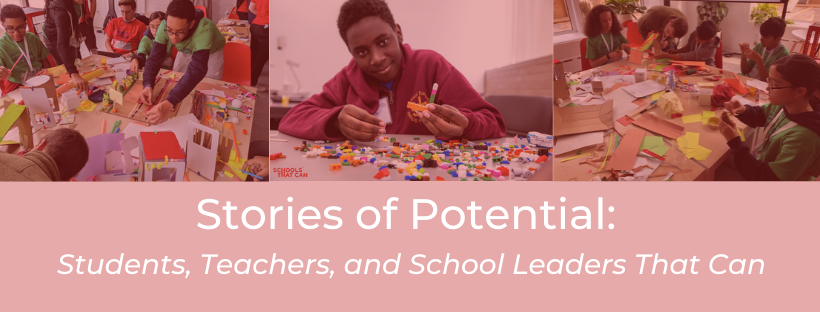
At Schools That Can, we believe all students, teachers, and school leaders can exceed their potential when given the opportunity. Our programs aim to do this by engaging students in real-world learning experiences, developing teachers’ capacity to facilitate such learning, and empowering school leaders to realize bold visions for success. In our Stories of Potential series, we are highlighting stories of students, teachers, and leaders that can achieve, inspire, and transform. It’s their work, growth, and perspective that demonstrates the power of real-world learning–and how it shapes our world.
Educational Solutions is a Charter Management Organization operating 3 schools serving students in Columbus, OH: Cesar Chavez College Preparatory School, Educational Academy for Boys and Girls, and Midnimo Cross-Cultural Middle School. Midnimo joined the Schools That Can network in 2015, and the Educational Solutions team has been actively engaged in STC’s national initiatives ever since.
Last year, Educational Solutions participated in the inaugural Incubator, run by the Transforming Learning Collaborative, a partnership between Schools That Can, Da Vinci Schools, and Next Generation Learning Challenges. The Transforming Learning Incubator is a year-long, educator-to-educator mentoring program that focuses on real-world learning, project-based learning, and more, helping schools develop and execute bold plans for changing their schools. “One key thing we learned by doing the TLC Incubator is to harness the energy and knowledge of our teachers and staff,” said Dr. Robert Stephens, Executive Director of Educational Solutions. “The teachers have been instrumental in driving our STEM offerings.”
This year, their elementary schoolers are entering the #STEMdriveOhio Design Challenge. Each year during a year-long challenge, students research, build, and test a solution to the given problem, then present the ideas. Stephens explained this year’s challenge is focused on improving transportation via smart mobility. In an interview, Rich Granger, managing director of workforce development for DriveOhio, explained “smart mobility” as “using emerging technologies to improve the mobility of people and goods.” “It’s a wonderful opportunity,” said Stephens, noting that the state of Ohio has transportation issues, so “ they are facilitating students to enter a design challenge to contribute to solving some of the problems.” Because transportation issues are so community-wide, Stephens said it is a “tailor-made problem for students.”
Stephens also noted that some in the Columbus community have raised questions, discussions, and negative publicity around some advancements like driverless cars, including whether such progress could hurt jobs in the community. “When we have these advancements, often they make new jobs,,” Stephens explained. “We just have to get prepared for the new jobs that advances in artificial intelligence, or what have you, will produce.” Stephens says that an “educated student bases” is critical to these kinds of discussions.
Beyond #STEMdrivesOhio, Educational Solutions has made other strides in real-world learning, too. “We have expanded our Real World Learning Program,” said Stephens. “We now have a full-time STEM teacher at each location.” That impacts classes the school offers, too. Currently, all schools serving grades 6-8 do a semester-long class spanning eighteen weeks using the ReadyAI curriculum and other STEM concepts. As part of this, students also create final projects for the World Artificial Intelligence Competition for Youth (WAICY).
STEM teachers have a theme for each day. On Manipulative Mondays, students focus on engineering using various STEM materials. On Tinkercad Tuesdays, students learn how to design objects for 3D printing, Stephens explained. “The objects that are printed will be used in the final WAICY project. On WAICY Wednesdays, students learn how to use the Cosmo Robot and the Calypso software to create their projects. On Thinking Thursdays, students do STEM design challenges. On Future Fridays, students explore STEM careers.”
The education to employment pipeline is of utmost importance to Stephens and Educational Solutions, and he notes that there is a big need for partners to facilitate authentic learning practices within that pipeline. “I am increasingly understanding the gap in connecting Education to Employment,” Stephens said. “The tragedy of students receiving credentials from secondary and post-secondary education that are not marketable to sustained employment/career tracks is very concerning.” That’s why Stephens believes real-world learning is so crucial to education. “To make students aware and connected to emerging technologies/career opportunities and to facilitate their exploration in these fields is a leading challenge in education today.”
Educational Solutions has also attended the Schools That Can National Forum several years in a row, and hopes to continue to invest in opportunities for Ohio students to grow their skills, confidence, and job readiness through real-world learning initiatives.

